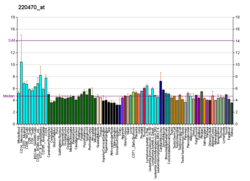From Wikipedia, the free encyclopedia
Protein-coding gene in the species Homo sapiens
BET1-like protein is a protein that in humans is encoded by the BET1L gene.[5][6][7]
BET1L has been shown to interact with:
- ^ a b c GRCh38: Ensembl release 89: ENSG00000177951 – Ensembl, May 2017
- ^ a b c GRCm38: Ensembl release 89: ENSMUSG00000025484 – Ensembl, May 2017
- ^ "Human PubMed Reference:". National Center for Biotechnology Information, U.S. National Library of Medicine.
- ^ "Mouse PubMed Reference:". National Center for Biotechnology Information, U.S. National Library of Medicine.
- ^ Xu Y, Wong SH, Zhang T, Subramaniam VN, Hong W (Sep 1997). "GS15, a 15-kilodalton Golgi soluble N-ethylmaleimide-sensitive factor attachment protein receptor (SNARE) homologous to rbet1". J Biol Chem. 272 (32): 20162–6. doi:10.1074/jbc.272.32.20162. PMID 9242691.
- ^ Oka T, Ungar D, Hughson FM, Krieger M (Apr 2004). "The COG and COPI complexes interact to control the abundance of GEARs, a subset of Golgi integral membrane proteins". Mol Biol Cell. 15 (5): 2423–35. doi:10.1091/mbc.E03-09-0699. PMC 404034. PMID 15004235.
- ^ "Entrez Gene: BET1L blocked early in transport 1 homolog (S. cerevisiae)-like".
- ^ a b c Shorter J, Beard MB, Seemann J, Dirac-Svejstrup AB, Warren G (Apr 2002). "Sequential tethering of Golgins and catalysis of SNAREpin assembly by the vesicle-tethering protein p115". J. Cell Biol. 157 (1): 45–62. doi:10.1083/jcb.200112127. PMC 2173270. PMID 11927603.
- ^ a b c Xu Y, Martin S, James DE, Hong W (Oct 2002). "GS15 forms a SNARE complex with syntaxin 5, GS28, and Ykt6 and is implicated in traffic in the early cisternae of the Golgi apparatus". Mol. Biol. Cell. 13 (10): 3493–507. doi:10.1091/mbc.E02-01-0004. PMC 129961. PMID 12388752.
- Andersson B, Wentland MA, Ricafrente JY, et al. (1996). "A "double adaptor" method for improved shotgun library construction". Anal. Biochem. 236 (1): 107–13. doi:10.1006/abio.1996.0138. PMID 8619474.
- Yu W, Andersson B, Worley KC, et al. (1997). "Large-scale concatenation cDNA sequencing". Genome Res. 7 (4): 353–8. doi:10.1101/gr.7.4.353. PMC 139146. PMID 9110174.
- Zhang QH, Ye M, Wu XY, et al. (2001). "Cloning and functional analysis of cDNAs with open reading frames for 300 previously undefined genes expressed in CD34+ hematopoietic stem/progenitor cells". Genome Res. 10 (10): 1546–60. doi:10.1101/gr.140200. PMC 310934. PMID 11042152.
- Venter JC, Adams MD, Myers EW, et al. (2001). "The sequence of the human genome". Science. 291 (5507): 1304–51. Bibcode:2001Sci...291.1304V. doi:10.1126/science.1058040. PMID 11181995.
- Zhang T, Hong W (2001). "Ykt6 forms a SNARE complex with syntaxin 5, GS28, and Bet1 and participates in a late stage in endoplasmic reticulum-Golgi transport". J. Biol. Chem. 276 (29): 27480–7. doi:10.1074/jbc.M102786200. PMID 11323436.
- Shorter J, Beard MB, Seemann J, et al. (2002). "Sequential tethering of Golgins and catalysis of SNAREpin assembly by the vesicle-tethering protein p115". J. Cell Biol. 157 (1): 45–62. doi:10.1083/jcb.200112127. PMC 2173270. PMID 11927603.
- Xu Y, Martin S, James DE, Hong W (2003). "GS15 forms a SNARE complex with syntaxin 5, GS28, and Ykt6 and is implicated in traffic in the early cisternae of the Golgi apparatus". Mol. Biol. Cell. 13 (10): 3493–507. doi:10.1091/mbc.E02-01-0004. PMC 129961. PMID 12388752.
- Strausberg RL, Feingold EA, Grouse LH, et al. (2003). "Generation and initial analysis of more than 15,000 full-length human and mouse cDNA sequences". Proc. Natl. Acad. Sci. U.S.A. 99 (26): 16899–903. Bibcode:2002PNAS...9916899M. doi:10.1073/pnas.242603899. PMC 139241. PMID 12477932.
- Ota T, Suzuki Y, Nishikawa T, et al. (2004). "Complete sequencing and characterization of 21,243 full-length human cDNAs". Nat. Genet. 36 (1): 40–5. doi:10.1038/ng1285. PMID 14702039.
- Tai G, Lu L, Wang TL, et al. (2005). "Participation of the syntaxin 5/Ykt6/GS28/GS15 SNARE complex in transport from the early/recycling endosome to the trans-Golgi network". Mol. Biol. Cell. 15 (9): 4011–22. doi:10.1091/mbc.E03-12-0876. PMC 515336. PMID 15215310.
- Gerhard DS, Wagner L, Feingold EA, et al. (2004). "The status, quality, and expansion of the NIH full-length cDNA project: the Mammalian Gene Collection (MGC)". Genome Res. 14 (10B): 2121–7. doi:10.1101/gr.2596504. PMC 528928. PMID 15489334.
- Kimura K, Wakamatsu A, Suzuki Y, et al. (2006). "Diversification of transcriptional modulation: large-scale identification and characterization of putative alternative promoters of human genes". Genome Res. 16 (1): 55–65. doi:10.1101/gr.4039406. PMC 1356129. PMID 16344560.





